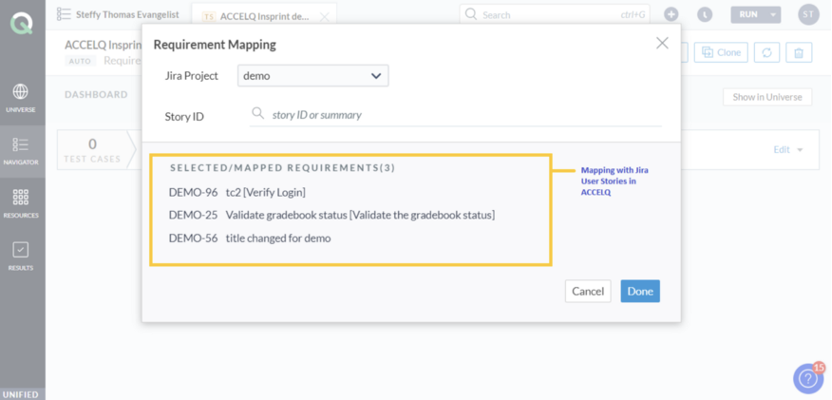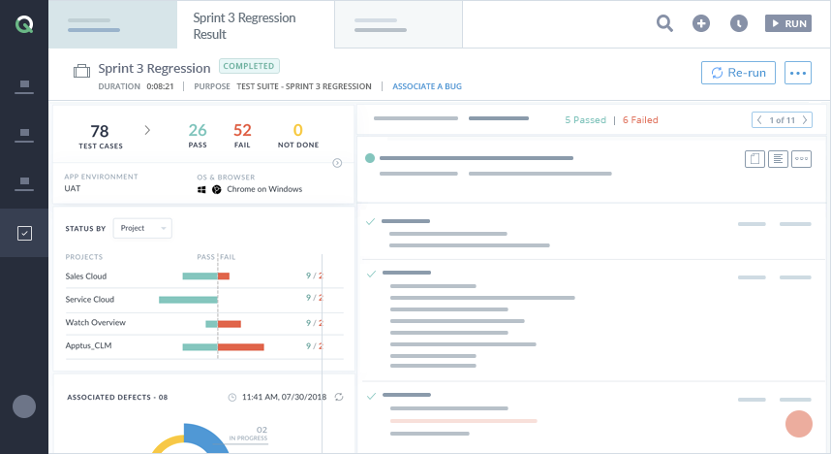
A blog about how ACCELQ — Low code automation solution helps in achieving in-sprint automation
Software test automation is the crucial phase of the software development life cycle and aims to make sure your product quality is maintained to the highest standards. With this in mind, there are many different approaches to test automation, especially when creating reliable and efficient automation cases. One such automation approach that is currently followed in software testing is In-sprint Automation.
In-sprint Automation

In-sprint test automation is a unique testing approach that is used in iterative and agile software development. It attempts to maximize the value of automated tests by leveraging short release cycles. Automating within product sprints is one of the most effective ways to increase your team’s efficiency, productivity, and alignment. In addition, it makes sure that everyone is focused and does the right work, ensuring that there is less automation debt in the project.
There are quite a few automation solutions available to support in-sprint automation. Software testing professionals have a wide range of solutions, from traditional automation tools like selenium to the latest technology of using no-code automation. However, many difficulties are faced with the traditional automation framework approach in automating and testing a feature within a sprint. As a result, testing professionals face a lot of time crunch for achieving in-sprint automation, which further impacts the automation debt of the project. In this blog post, I will summarize how in-sprint automation can be achieved and provide insights into how ACCELQ helps in achieving in-sprint automation with its unique aspects. To begin with, let us first understand what is required to achieve successful in-sprint automation.
What does it take to achieve truly effective automation in the sprint cycle?
Test automation is a common challenge for most product teams. Many teams struggle to automate their tests within the same sprint that the feature is developed, thus leading to technical debt. So what can be done to achieve effective automation within the sprint
Start automation during the development phase
A sprint is usually considered for two weeks. Within the two weeks, developers and testers have to ensure completion of user story development+testing+test automation. During the testing phase of the feature, a majority of time is invested in creating test automation. Most of the time, testing professionals cannot start with automation if the feature is not ready, leading to a time crunch at the end of the sprint. To achieve in-sprint automation and ensure the maximum productivity of software testers, it would be a better approach to start automation during the development phase.
Faster test case execution
Having many test cases automated won’t help if your automation framework doesn’t have a supporting infrastructure for quick test case execution. In-sprint automation is time-bound, so it is required that each test case can run independently to support parallel execution. This can ensure that in case of failures, they can be caught and fixed quickly.
Easy maintenance of Automation code
Introduction of a new feature can hamper the existing automation code. There can be changes in element locators, redirection links, etc. This can further cause and hinder achieving the in-sprint timelines. It is vital that the automation framework supports features such as self-heal and, it should be easy for anyone on the team to read and debug the issues faster.
Right automation skills
This is a crucial point to be considered for in-sprint test automation. Test professionals in the team should be highly knowledgeable regarding the automation tool used for automating the feature. Having the right skills can accelerate the timelines in which the feature can be automated.
Smart automation tools
Traditional automation approach makes it mandatory for testers to learn programming languages. Working on automation with this approach is time-consuming. The error handling messages also provided in the console are not user-friendly, leading to investing a lot of time debugging and resolving the errors. Today, we have more intelligent low-code automation tools which allow testing professionals to focus more on automating the feature instead of understanding or rectifying the framework-related issues. Testers will get more time to test the feature as these automation solutions will take care of most of the automation features provided by any framework.
What makes ACCELQ- Low code automation tool unique to achieve in-sprint automation?

ACCELQ brings together the best of AI and human ingenuity to help companies launch high-quality software on time, every time. From test design to test execution and reporting, ACCELQ utilizes the combined power of AI and experienced QA engineers. Let us view some more features from ACCELQ that helps in achieving in-sprint automation
1. Ability to drive automation when the feature is still in the development phase
For in-sprint automation to succeed, it is important to start with the automation when the feature is still in the development phase. This will ensure that software testers can focus on testing the project instead of developing automation code when the feature is out for testing. ACCELQ has this amazing feature of creating test scenarios and automating them to specific endpoints during the development phase of the requirement. Then, once the feature is out for testing, it seamlessly helps to reconcile the new feature with the automation code. This ensures that testing professionals are at their most productive front during the development and testing phases and helps provide a quality product at the end of the sprint cycle.
2. Integration with a project management tool to track automated cases

A project management tool allows you to quickly establish a hierarchy of tasks for effective and efficient completion. It gives us a picture of the current stage of the new requirements and a one-stop view of the status of the feature. It is required to have the automation status also integrated with the project management tool so that all stakeholders can access and view the automation results for the project. ACCELQ has considered this requirement and is integrated with JIRA — a project management tool to plan, track and manage agile software development projects. This integration allows teams to view automation results in JIRA user stories with every run of the automation suite.
3. Data variation in Test cases
ACCELQ offers an in-built data variation approach for test cases. This low code automation solution has even provided a feature to auto-generate combinations and includes them during test automation execution. This simple feature is highly beneficial for testing professionals since a wide range of data can be tested with automation with just a click of few buttons.
4. Automation Reports

ACCELQ Reports give you a centralized reporting platform to see the reports from all of your existing tests in one place. It allows you to define various filters to drill down your test reports and see the most recent results. In addition, it provides functional insights into the test execution results, giving you the ability to quickly identify and fix automation issues that prevent your tests from running successfully. Finally, test Reports provide a unified execution results view of both local and external execution results like BrowserStack, SauceLabs, etc.
5. Seamless integration for bug reporting and tracking
This one is one of the best features that ACCELQ offers and helps reduce a lot of software testers’ effort. In case of automation failures, a bug can be created in the JIRA project tracking tool with just the click of a button. Moreover, all the details related to the automation failure are attached in JIRA through this bug reporting integration.
My Takeaway
ACCELQ has redefined the way test automation can be successfully achieved within the sprint. ACCELQ focuses on real-time problems test automation engineers face during in-sprint automation and has enhanced its automation solutions to provide solutions for the same.
Related Posts
 Importance Of Business Value of Testing
Importance Of Business Value of Testing
Importance Of Business Value of Testing
 7 Testing Topics that 95% Testers Miss Out On
7 Testing Topics that 95% Testers Miss Out On


































